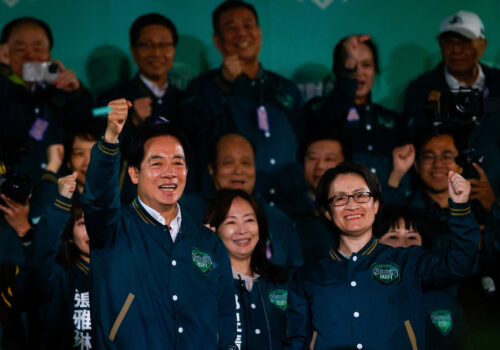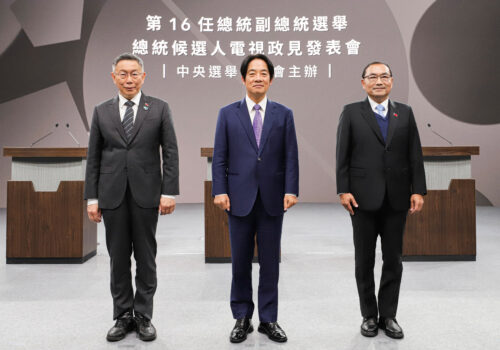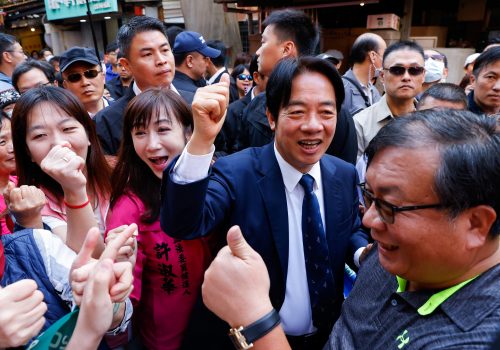Lai’s victory isn’t the full story. Here are five deeper takeaways from Taiwan’s election.

Taiwan’s January 13 election captured the world’s attention. Lai Ching-te, the Democratic Progressive Party (DPP) candidate and current vice president, won the presidential race. Many geopolitical watchers around the world noted that Lai’s victory will in many ways mark a continuity with current Taiwanese President Tsai Ing-wen, and then they turned their focus to other issues around the world. But it’s worth studying the election results in more detail because the picture that emerges is more complex. Here are five takeaways from Taiwan’s recent national election:
1. It was a good—not great—victory for the DPP
Lai won with 40 percent of the vote with the Kuomintang (KMT) coming in second with 33 percent of the vote. Receiving less than 50 percent may seem like a major loss for the DPP. But, in the lead-up to the election, speculation ran wild about the DPP and the KMT being neck-and-neck with each other. In the end, the DPP won with a clear 7 percent lead. That is a meaningful victory for the party. At the same time, it is impossible to ignore that Lai’s 40 percent is far lower than the 57 percent that Tsai received in 2020. The overall numbers reflect the DPP’s ability to fully mobilize its base of support within Taiwanese civil society—but the party apparently struggled to win over median and undecided voters.
2. It was a great—not simply good—result for the TPP
Ko Wen-je of the new Taiwan People’s Party (TPP) received a solid 26 percent of the presidential vote. After the KMT-TPP alliance broke down in November, Ko fell in the polls while the KMT was able to maintain their strong second-place lead. Going into the elections, the odds of strategic voting seemed very likely—meaning that Ko’s base of support was likely to vote for the DPP or the KMT, in order to avoid “wasting” their vote for Ko. But on election day, Ko’s supporters stood by their candidate. The 26 percent result shows that Ko’s base of support is meaningful and real—and was not swayed by either the DPP or the KMT.
Early in the presidential electoral cycle, the TPP performed relatively well in the opinion polls, in part thanks to its strong messaging strategy. Even still, there was doubt about whether the upstart third party, with its embryonic party infrastructure and smaller political donor base, would see its support decline as the race entered its closing weeks, when differentials in party machinery and campaign financing matter most. But TPP dispelled those concerns.
What brought the TPP success? There is no singular reason, but rather a perfect combination of factors: incumbency bias against eight years of the DPP, voters generally dissatisfied with the two major parties, and Ko’s quirky cult-of-personality approach to politics. Policy-wise, Ko tried to focus more on domestic issues, but like every other candidate, he also faced intense questioning on how he would approach Beijing and cross-strait relations. Although it may be tempting to say that Ko’s appeal is only based on his charisma or his discussion of domestic politics, support for Ko varies widely based on age, political affiliation, and a host of other factors. Whether Ko can sustain and build on this support in four years will be a big topic ahead of the 2028 presidential election.
Critically, Ko and the TPP’s success this year was not merely symbolic. By receiving 22 percent of the proportional representation votes, the party earned eight seats in the Legislative Yuan. The DPP and the KMT were both unable to secure a majority, which means the TPP now plays the role of “kingmaker” in the Legislative Yuan. If the DPP or the KMT want to pass policy, then they must work with the TPP. This small party, despite coming in third place, still managed to find a meaningful position of power for themselves.
Taiwan’s political system has officially entered its three-party era, after almost four decades of a two-party system.
3. The KMT faces a choice of reinvention or doubling down
The KMT performed in line with expectations, winning over one third of the presidential ballots and falling just short of attaining a majority in the legislature. It is nonetheless the third straight loss at the presidential level for the KMT, and its fifth loss overall since Taiwan began direct presidential elections in 1996.
The KMT will no doubt undertake a post-mortem analysis, similar to what most parties engage in after a loss. In particular, the party will need to decide whether to double down or to de-emphasize the cross-strait dimension of its platform. On the more tactical side, it will need to assess whether its primary framing of the election as a choice between “war or peace” is still a winning pitch and whether it is a misstep that ceded bread-and-butter-issue protest votes to the TPP.
4. Divided legislature poses a governance challenge
For the first time since 2008, Taiwan is entering into an era of divided government, in which the party of the president does not control a majority in the legislature. That means the incoming president will face greater challenges in securing legislative backing for any bills he may wish to pass, including appropriation bills to finance his policy agenda. The divided government thus presents a structural barrier that threatens to slow down governance and policy making.
That Taiwan’s legislature will not be KMT-majority but opposition majority (KMT plus the TPP) may create more potential for the DPP to build occasional coalitions with either the KMT or the TPP to overcome partisan gridlock. But that opportunity may also entail uncertainty—if every new bill is open to new coalition-building possibilities, then every new bill will require strategists on all sides to reinvent the wheel every single time, slowing down legislation.
The world will be watching whether Lai will exhibit the kind of exceptional statesmanship necessary to overcome such structural barriers and forge stable governing coalitions. He may also need to pacify dissent and uneasiness from within the DPP’s own ranks about working with the party’s opponents.
5. China’s response may come now, or it may come later
The People’s Republic of China (PRC) has already reacted to the DPP’s victory in several ways. It first expressed strong language through the Taiwan Affairs Office, condemning the election with its typical rhetoric. But the strongest move came with Nauru switching formal diplomatic recognition from Taiwan to China just a day after the election. Although losing another formal ally is meaningful, it is not entirely unexpected. Poaching Taiwan’s diplomatic allies is a tried and true Beijing tactic to register dissent and exert pressure against Taiwan.
And the PRC’s reactions may not be over. Lai himself will not become president until May. When Lai makes his inauguration speech, all ears will be on his language and framing of his administration. The PRC will have a second key opportunity to react to Lai and his presidency then, depending on the nature of his inauguration.
Lev Nachman is a nonresident fellow with the Atlantic Council’s Global China Hub and an assistant professor in the College of Social Science at National Chengchi University. He holds his PhD in Political Science from the University of California Irvine and is a former Taiwan Studies Postdoctoral Research Fellow at the Harvard Fairbank Center for China Studies.
Wen-Ti Sung is a nonresident fellow with the Atlantic Council’s Global China Hub. He is a sessional lecturer in the Australian National University’s College of Asia and the Pacific, and a member of the Australian Centre on China in the World.
Further reading
Sat, Jan 13, 2024
Experts react: Taiwan just elected Lai Ching-te as president despite China’s opposition. What’s next?
New Atlanticist By
Atlantic Council experts explain what a Lai presidency will mean for Taiwan’s foreign policy trajectory—and how China is likely to respond.
Wed, Jan 3, 2024
Why Beijing’s latest pre-election attempt to coerce Taiwanese voters could backfire
New Atlanticist By Lev Nachman, Wen-Ti Sung
China recently said that it would end preferential tariff terms for some Taiwanese chemical exports. But the move may drive some Taiwanese voters away from the direction Beijing wants.
Tue, Dec 19, 2023
What to know about China’s meddling in Taiwan’s upcoming election
New Atlanticist By Lev Nachman, Wen-Ti Sung
China's approach to spreading misinformation to influence Taiwan's upcoming elections has become more subtle and, perhaps, more effective.
Image: A TPP supporter was cheering in Taipei, Taiwan on Sunday evening, Jan 13, 2024. (Photo by Alex Chan Tsz Yuk/Sipa USA)No Use Germany.


